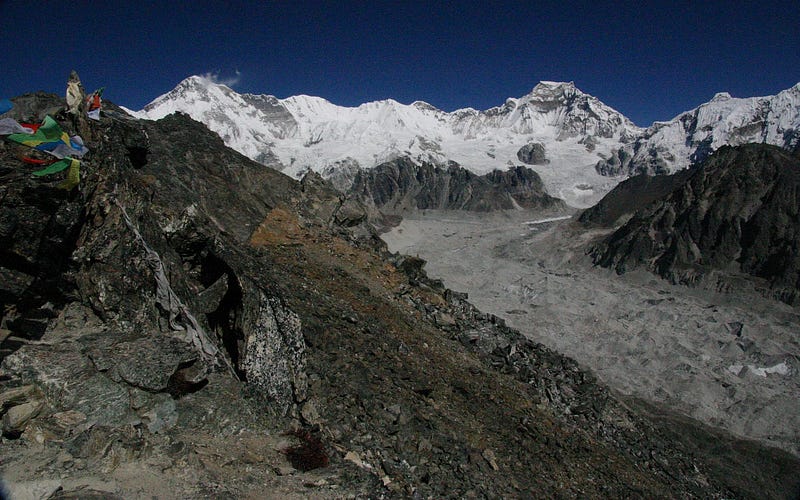A Journey Across Nepal's Ngozumpa Glacier: A Melting Marvel
Written on
Chapter 1: The Splendor of Ngozumpa Glacier
The Ngozumpa Glacier, recognized as Nepal's longest glacier, presents an almost surreal expanse of ice and rock, rapidly diminishing in size. From the vantage point of a Himalayan griffon, this glacier appears as an elongated gray streak snaking through the Gokyo Valley. The western segment traces its origins to the southern flank of Cho Oyu, which holds the title of the sixth tallest mountain in the world. Meanwhile, its northeastern branch unfurls across the southern slopes of Gyachung Kang, the fifteenth highest peak, while the eastern stretch begins on the southeastern inclines of Hungchi, located along the border with the Tibet Autonomous Region of China.
The glacier’s surface is predominantly gray, interspersed with striking blue areas and cloaked in a thick layer of debris and glacial boulders. Towering peaks encircle it, and it features occasional meltwater pools, bordered on the west by a series of fifteen stunning turquoise lakes collectively known as the Gokyo Lakes, which represent the highest freshwater lake system globally. At the southern edge of the glacier lies a collection of lakes formed from its meltwater, known as Spillway Lake, held back by a substantial moraine.
Standing atop the eastern moraine of the Ngozumpa Glacier, the scenery resembled an otherworldly realm of ice, rock, and vibrant turquoise meltwater pools. The glacier’s surface is a tapestry of hills and gravel mounds, shaped by its flow over millennia. Glacial spurs rise and fall like frozen waves on a shimmering sea, while the sounds of crumbling rubble echo ominously in the air. The ice itself creaks and groans, with streams bubbling just beneath its surface. Our route across the glacier meandered along rock cairns, occasionally disrupted by rockslides or fissures formed as the glacier moved and fractured under its own weight. Gazing across the lunar landscape, I could see the western moraine shrouded in ominous gray clouds that lingered above the valley.

The Ngozumpa Glacier stretches a remarkable 36 kilometers (approximately 22 miles) from the southern slopes of Cho Oyu to its terminal moraine in the Gokyo Valley, just above the villages of Nha and Chhamtyang. The upper parts are nourished by avalanches cascading down the mountains, while the lower sections are cloaked in a thick layer of rock and debris. Formed during the Pleistocene epoch around two million years ago, the glacier was once significantly larger. The surrounding mountains bear marks of this ancient era, with the valley shaped like a "U" by the glacier's flow.
However, in recent decades, the glacier has experienced significant melting. Research from the University of Cambridge revealed that between 2010 and 2015, an estimated 82.6 million cubic meters of ice were lost, resulting in a thinning of about three meters. Much of the melting ice has pooled to create the many turbid turquoise ponds scattered across its surface, although the majority of melting occurs beneath the surface through intricate englacial drainage systems.
Some of the meltwater journeys downhill to merge with the Dudh Kosi River, the source of which is the Ngozumpa Glacier. However, a significant amount collects at the glacier's southern terminus, where it is blocked by the terminal moraine, forming a series of supraglacial lakes. Scientists have observed these lakes grow from small, disconnected bodies of water to a larger expanse known as Spillway Lake. Should melting rates persist, this lake could expand to six kilometers in length, one kilometer in width, and 100 meters deep. If the moraine damming Spillway Lake were to fail, the consequences could be devastating, unleashing floods down the Gokyo Valley and jeopardizing numerous villages in the lower Khumbu region.
As we trekked across the vast gray expanse of the Ngozumpa Glacier on a cloudy afternoon in late March 2022, I was unaware of its dire state. The path appeared endless, with the western moraine seeming ever distant after an hour of navigating slopes, ridgelines, and steep mounds where the trail had vanished or been obstructed by shifting ice. Yellow-billed choughs flitted among the clouds overhead, while tufts of tundra grass clung to some mounds, nourished by soil transported by the glacier over centuries. Eventually, we reached the base of the western moraine, a steep wall of loose scree towering about one hundred meters high. A faint trail wound its way up, precariously positioned beneath enormous boulders that appeared ready to tumble.
Suddenly, one of these boulders gave way, racing down the slope with enough force to cause serious injury.
“Wow, that was close!” exclaimed Franz.
“I wouldn’t want to be in the path of that,” I replied. “Let’s keep moving.”
“We need to hurry,” Jakob urged. “Let’s minimize our risk.”
And with that, he dashed toward the top of the moraine.
Chapter 2: The Reality of Melting Glaciers
Video Description: Join us as we explore an abandoned Himalayan town and traverse the majestic Ngozumpa Glacier, experiencing the wonders of nature in Nepal.
Video Description: Watch as we navigate the challenges of crossing the Ngozumpa Glacier in the Everest region, witnessing firsthand the impacts of climate change.